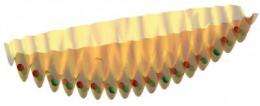Simply Weird Stuff: Making Supersolids with Ultracold Gas Atoms

ĚÇĐÄĘÓƵicists at the Joint Quantum Institute (JQI) of the National Institute of Standards and Technology and the University of Maryland have proposed a recipe for turning ultracold “boson” atoms—the ingredients of Bose-Einstein condensates—into a “supersolid,” an exotic state of matter that behaves simultaneously as a solid and a friction-free superfluid. While scientists have found evidence for supersolids in complex liquid helium mixtures, a supersolid formed from such weakly interacting gas atoms would be simpler to understand, potentially providing clues for making a host of new “quantum materials” whose bizarre properties could expand physicists’ notions of what is possible with matter.
First theorized in 1970, a supersolid displays the essential characteristics of a solid, with atoms arranged in regularly repeating patterns like that of a crystal lattice, and of a superfluid, with the particles flowing frictionlessly and without losing any energy. Able to exist only at low temperatures, a supersolid behaves very differently from objects in the everyday world.
“If you add more clothing to a spinning washing machine, you increase the mass of its rim, and the machine needs to exert a greater force to make the wheel reverse direction,” explains lead author Ludwig Mathey. “But in a supersolid washing machine, some of the clothes would mysteriously hover in space, staying stationary as the washer spins and making it easier for the wheel to reverse direction. Moreover, these hovering, frictionless clothes would form a predictable pattern—such as frictionless socks alternating with frictionless shirts—just as atoms arrange themselves in a repeating pattern in a crystal.”
In 2004, Moses Chan and Eun-Seong Kim of Pennsylvania State University published a groundbreaking experiment on helium at low temperatures and gathered evidence for a supersolid phase. However, the interpretation of their observations has considerable uncertainties due to the complex nature of the particular system used in their experiments.
Now physicists Ludwig Mathey, Ippei Danshita and Charles Clark have identified a technique for making a simpler-to-understand supersolid, using two species of ultracold atoms confined in an optical lattice, a “web of light” that traps atoms in regular positions. In a paper* to be published in ĚÇĐÄĘÓƵical Review A, the JQI team identifies conditions under which a cloud of ultracold atoms of two species (such as rubidium and sodium, or two slightly different forms of rubidium) can spontaneously condense into a state in which there is crystalline structure in the relative positions of atoms, e.g. a chain in which the two different types of atoms alternate regularly, but in which the entire cloud exhibits the frictionless, superfluid properties of a Bose-Einstein condensate (BEC). This remains hard to visualize in familiar terms—the accompanying image shows an artist’s conception of it—but the team identified clear experimental signatures (essentially photographs of the cloud), which could verify the simultaneous existence of these two seemingly incompatible properties.
The underlying technologies of optical lattices and Bose-Einstein condensation were pioneered at NIST and have sparked a renaissance in atomic physics with applications to NIST’s fundamental measurement missions, such as time and frequency standards and improved sensors of magnetic and gravitational forces. The supersolid is an example of a further direction of research in ultracold atomic physics: the design of quantum materials with fundamental properties not previously found in familiar matter.
Note:
* L. Mathey, I. Danshita and C. W. Clark, Creating a supersolid in one-dimensional Bose mixtures. ĚÇĐÄĘÓƵical Review A. Published as a Rapid Communication on Jan. 12, 2009.
Source: National Institute of Standards and Technology





















